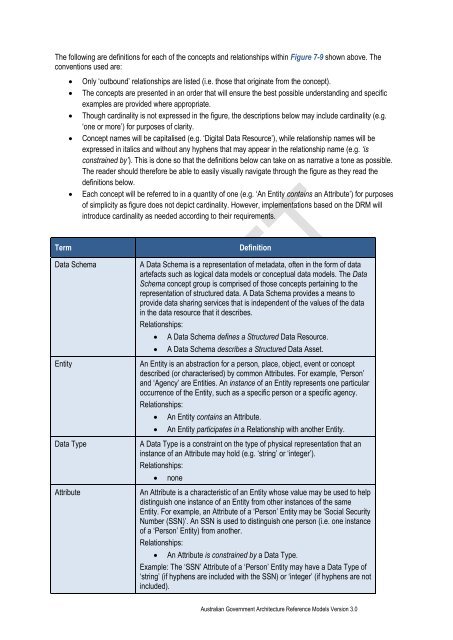Australian Government Architecture Reference Models Version 3.0
Australian Government Architecture Reference Models Version 3.0
Australian Government Architecture Reference Models Version 3.0
Create successful ePaper yourself
Turn your PDF publications into a flip-book with our unique Google optimized e-Paper software.
The following are definitions for each of the concepts and relationships within Figure 7-9 shown above. The<br />
conventions used are:<br />
� Only ‘outbound’ relationships are listed (i.e. those that originate from the concept).<br />
� The concepts are presented in an order that will ensure the best possible understanding and specific<br />
examples are provided where appropriate.<br />
� Though cardinality is not expressed in the figure, the descriptions below may include cardinality (e.g.<br />
‘one or more’) for purposes of clarity.<br />
� Concept names will be capitalised (e.g. ‘Digital Data Resource’), while relationship names will be<br />
expressed in italics and without any hyphens that may appear in the relationship name (e.g. ‘is<br />
constrained by’). This is done so that the definitions below can take on as narrative a tone as possible.<br />
The reader should therefore be able to easily visually navigate through the figure as they read the<br />
definitions below.<br />
� Each concept will be referred to in a quantity of one (e.g. ‘An Entity contains an Attribute’) for purposes<br />
of simplicity as figure does not depict cardinality. However, implementations based on the DRM will<br />
introduce cardinality as needed according to their requirements.<br />
Term Definition<br />
Data Schema<br />
Entity<br />
Data Type<br />
Attribute<br />
A Data Schema is a representation of metadata, often in the form of data<br />
artefacts such as logical data models or conceptual data models. The Data<br />
Schema concept group is comprised of those concepts pertaining to the<br />
representation of structured data. A Data Schema provides a means to<br />
provide data sharing services that is independent of the values of the data<br />
in the data resource that it describes.<br />
Relationships:<br />
� A Data Schema defines a Structured Data Resource.<br />
� A Data Schema describes a Structured Data Asset.<br />
An Entity is an abstraction for a person, place, object, event or concept<br />
described (or characterised) by common Attributes. For example, ‘Person’<br />
and ‘Agency’ are Entities. An instance of an Entity represents one particular<br />
occurrence of the Entity, such as a specific person or a specific agency.<br />
Relationships:<br />
� An Entity contains an Attribute.<br />
� An Entity participates in a Relationship with another Entity.<br />
A Data Type is a constraint on the type of physical representation that an<br />
instance of an Attribute may hold (e.g. ‘string’ or ‘integer’).<br />
Relationships:<br />
� none<br />
An Attribute is a characteristic of an Entity whose value may be used to help<br />
distinguish one instance of an Entity from other instances of the same<br />
Entity. For example, an Attribute of a ‘Person’ Entity may be ‘Social Security<br />
Number (SSN)’. An SSN is used to distinguish one person (i.e. one instance<br />
of a ‘Person’ Entity) from another.<br />
Relationships:<br />
� An Attribute is constrained by a Data Type.<br />
Example: The ‘SSN’ Attribute of a ‘Person’ Entity may have a Data Type of<br />
‘string’ (if hyphens are included with the SSN) or ‘integer’ (if hyphens are not<br />
included).<br />
<strong>Australian</strong> <strong>Government</strong> <strong>Architecture</strong> <strong>Reference</strong> <strong>Models</strong> <strong>Version</strong> <strong>3.0</strong><br />
211

















